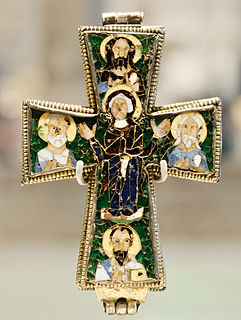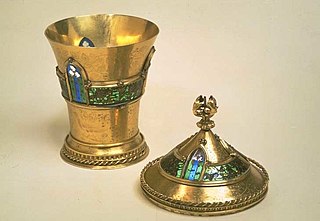 W
WVitreous enamel, also called porcelain enamel, is a material made by fusing powdered glass to a substrate by firing, usually between 750 and 850 °C. The powder melts, flows, and then hardens to a smooth, durable vitreous coating. The word comes from the Latin vitreum, meaning "glass".
 W
WBasse-taille (bahss-tah-ee) is an enamelling technique in which the artist creates a low-relief pattern in metal, usually silver or gold, by engraving or chasing. The entire pattern is created in such a way that its highest point is lower than the surrounding metal. A translucent enamel is then applied to the metal, allowing light to reflect from the relief and creating an artistic effect. It was used in the late Middle Ages, and then again in the 17th century.
 W
WThe Benty Grange hanging bowl is a fragmentary Anglo-Saxon artefact from the seventh century AD. All that remains are two escutcheons; a third disintegrated soon after excavation, and no longer survives. The escutcheons were found in 1848 by the antiquary Thomas Bateman, while excavating a tumulus at the Benty Grange farm in western Derbyshire, and were undoubtedly buried as part of an entire hanging bowl. The grave had probably been looted by the time of Bateman's excavation, but still contained high-status objects suggestive of a richly furnished burial, including the hanging bowl and the Benty Grange helmet.
 W
WThe craft of cloisonné enameling is a metal and glass-working tradition practiced in the Byzantine Empire from the 6th to the 12th century AD. The Byzantines perfected an intricate form of vitreous enameling, allowing the illustration of small, detailed, iconographic portraits.
 W
WChamplevé is an enamelling technique in the decorative arts, or an object made by that process, in which troughs or cells are carved, etched, die struck, or cast into the surface of a metal object, and filled with vitreous enamel. The piece is then fired until the enamel fuses, and when cooled the surface of the object is polished. The uncarved portions of the original surface remain visible as a frame for the enamel designs; typically they are gilded in medieval work. The name comes from the French for "raised field", "field" meaning background, though the technique in practice lowers the area to be enamelled rather than raising the rest of the surface.
 W
WA chasse, châsse or box reliquary is a shape commonly used in medieval metalwork for reliquaries and other containers. To the modern eye the form resembles a house, though a tomb or church was more the intention, with an oblong base, straight sides and two sloping top faces meeting at a central ridge, often marked by a raised strip and decoration. From the sides there are therefore triangular "gable" areas.
 W
WCloisonné is an ancient technique for decorating metalwork objects with colored material held in place or separated by metal strips or wire, normally of gold. In recent centuries, vitreous enamel has been used, but inlays of cut gemstones, glass and other materials were also used during older periods; indeed cloisonné enamel very probably began as an easier imitation of cloisonné work using gems. The resulting objects can also be called cloisonné. The decoration is formed by first adding compartments to the metal object by soldering or affixing silver or gold as wires or thin strips placed on their edges. These remain visible in the finished piece, separating the different compartments of the enamel or inlays, which are often of several colors. Cloisonné enamel objects are worked on with enamel powder made into a paste, which then needs to be fired in a kiln. If gemstones or colored glass are used, the pieces need to be cut or ground into the shape of each cloison.
 W
WLe Creuset is a premium French cookware manufacturer best known for its colourfully-enameled cast-iron cookware "French ovens", also known as "cocottes" or "coquelles" and "sauce pans" or "casseroles". The company also makes many other types of cookware and bakeware, from fondue-sets to tagines.
 W
WEnamelled glass or painted glass is glass which has been decorated with vitreous enamel and then fired to fuse the glasses. It can produce brilliant and long-lasting colours, and be translucent or opaque. Unlike most methods of decorating glass, it allows painting using several colours, and along with glass engraving, has historically been the main technique used to create the full range of image types on glass.
 W
WThe House of Fabergé is a jewellery firm founded in 1842 in Saint Petersburg, Russia, by Gustav Faberge, using the accented name Fabergé. Gustav's sons, Peter Carl and Agathon, and grandsons followed him in running the business until it was nationalised by the Bolsheviks in 1918. The firm was famous for designing elaborate jewel-encrusted Fabergé eggs for the Russian Tsars, and for a range of other work of high quality and intricate detail. In 1924, Peter Carl's sons Alexander and Eugène Fabergé opened Fabergé & Cie in Paris, making similar jewellery items and adding the name of the city to their rival firm's trademark, styling it FABERGÉ, PARIS.
 W
WGrisaille is a painting executed entirely in shades of grey or of another neutral greyish colour. It is particularly used in large decorative schemes in imitation of sculpture. Many grisailles include a slightly wider colour range, like the Andrea del Sarto fresco illustrated. Paintings executed in brown are referred to as brunaille, and paintings executed in green are called verdaille.
 W
WGuilloché is a decorative technique in which a very precise, intricate and repetitive pattern is mechanically engraved into an underlying material via engine turning, which uses a machine of the same name, also called a rose engine lathe. This mechanical technique improved on more time-consuming designs achieved by hand and allowed for greater delicacy, precision, and closeness of line, as well as greater speed.
 W
WHanging bowls are a distinctive type of artefact of the period between the end of Roman rule in Britain in c. 410 AD and the emergence of the Christian Anglo-Saxon kingdoms during the 7th century. The surviving examples have mostly been found in Anglo-Saxon graves, but there is general agreement that they reflect Celtic traditions of decoration.
 W
WThe Khalili Collection of Enamels of the World is a private collection of enamel artworks from the period 1700 to 2000, assembled by the British-Iranian scholar, collector and philanthropist Nasser D. Khalili. It is one of the eight Khalili Collections, each of which is considered among the most important in its field.
 W
WKin'unken was a Japanese cloisonné making company located in Kyoto, western Japan.
 W
WLimoges enamel has been produced at Limoges, in south-western France, over several centuries up to the present. There are two periods when it was of European importance. From the 12th century to 1370 there was a large industry producing metal objects decorated in enamel using the champlevé technique, of which most of the survivals, and probably most of the original production, are religious objects such as reliquaries.
 W
WMinakari or Meenakari is the process of painting and colouring the surfaces of metals and ceramic tiles through enameling originating in Safavid Iran. It is practiced as an art form and commercially produced mainly in Iran, Afghanistan, Pakistan and India. Minakari art usually involves intricate designs and is applied as a decorative feature to serving dishes, containers, vases, frames, display ornaments and jewelry.
 W
WMosan art is a regional style of art from the valley of the Meuse in present-day Belgium, the Netherlands, and Germany. Although in a broader sense the term applies to art from this region from all periods, it generally refers to Romanesque art, with Mosan Romanesque architecture, stone carving, metalwork, enamelling and manuscript illumination reaching a high level of development during the 11th, 12th and 13th centuries.
 W
WPlique-à-jour is a vitreous enamelling technique where the enamel is applied in cells, similar to cloisonné, but with no backing in the final product, so light can shine through the transparent or translucent enamel. It is in effect a miniature version of stained-glass and is considered very challenging technically: high time consumption, with a high failure rate. The technique is similar to that of cloisonné, but using a temporary backing that after firing is dissolved by acid or rubbed away. A different technique relies solely on surface tension, for smaller areas. In Japan the technique is known as shotai-jippo, and is found from the 19th century on.
 W
WRonde-bosse, en ronde bosse or encrusted enamel is an enamelling technique developed in France in the late 14th century that produces small three-dimensional figures, or reliefs, largely or entirely covered in enamel. The new method involved the partial concealment of the underlying gold, or sometimes silver, from which the figure was formed. It differs from older techniques which all produced only enamel on a flat or curved surface, and mostly, like champlevé, normally used non-precious metals, such as copper, which were gilded to look like gold. In the technique of enamel en ronde-bosse small figures are created in gold or silver and their surfaces lightly roughened to provide a key for the enamel, which is applied as a paste and fired. In places the framework may only be wire.
 W
WStaub is a premium French enameled cast iron cookware and bakeware manufacturer that was originally headquartered in Turckheim, Alsace, France. The first piece, a cocotte or coquelle, was designed by Francis Staub in 1974 in a dormant artillery factory. Pieces are manufactured with cast iron covered with double-glazed enamel. The enamel coating makes the cookware rustproof, and easy to clean. Staub's cocottes have nubs on the interior of the lids, which enables condensation to collect and drip down to baste foods uniformly as they are cooking.